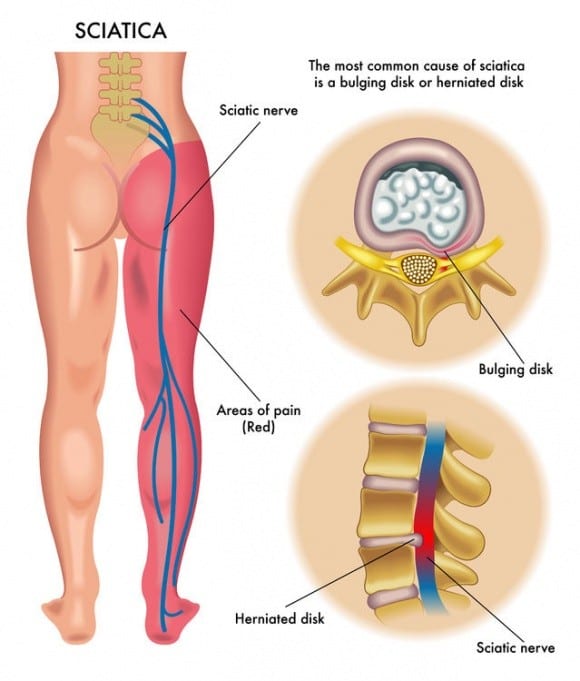Several lumbar spine (lower back) disorders can cause sciatica. Sciatic nerve pain is frequently described as mild to extreme pain at the right or left leg. Sciatica is caused by compression of one or more of the five sets of nerve roots in the lower spine. Sometimes doctors call sciatica a radiculopathy.
Radiculopathy is a medical term used to describe pain, numbness, tingling sensations, and weakness in the arms or legs caused by a nerve root issue. If the nerve problem is in the neck, it is referred to as a cervical radiculopathy. But since sciatica affects the low back, or the lumbar spine, it is known as a lumbar radiculopathy.
Pathways to Reduce Sciatic Nerve Pain
Five sets of nerve roots at the lumbar spine unite to create the sciatic nerve. Starting in the rear of the pelvis (sacrum), the sciatic nerve runs in the back, under the buttock, and downward through the hip area into every leg and foot. Nerve roots aren't "solitary" structures but are part of the body's whole nervous system capable of transmitting pain and feeling to other areas of the body.
Radiculopathy occurs when compression of a nerve root from a disc rupture (herniated disc) or bone spur (osteophyte) happens in the lumbar spine before it joins the sciatic nerve.

Causes of Sciatic Nerve Pain
Several spinal disorders can lead to spinal nerve pain and compression or lumbar radiculopathy. The 6 leading causes of sciatic nerve pain are:
- a bulging or herniated disc
- lumbar spinal stenosis
- spondylolisthesis
- trauma from an injury
- piriformis syndrome
- spinal tumors
Lumbar Bulging Disc or Herniated Disc
A bulging disc is also known as a contained disc disorder. This means that the gel-like center (nucleus pulposus) of an intervertebral disc stays "contained" within the tire-like outer wall (annulus fibrosus) of the intervertebral disc.
A herniated disc occurs when the nucleus pulposus breaks through the annulus fibrosus. It's known as a "non-contained" disc disorder. If the disc bulges or herniates, disc material can push against an adjacent nerve root and compress delicate nerve tissue and lead to sciatica.
The results of a herniated disc may often be worse. When the herniated disc causes direct compression of the nerve root from the inside of the bony spinal canal, the disc material itself also includes an acidic, chemical irritant (lipoic acid) which causes nerve irritation. In both situations, nerve compression and irritation cause pain and inflammation, often leading to extremity numbness, tingling sensations, and muscle fatigue.
Lumbar Spinal Stenosis
Spinal stenosis is a nerve compression disease most frequently affecting older adults. Leg pain similar to sciatica may happen as a result of lumbar spinal stenosis. The pain is generally positional, frequently brought on by actions like standing or walking and relieved by sitting down.
Spinal nerve roots branch outward in the spinal cord through passageways called neural foramina comprised of bone and ligaments. Between each set of vertebrae, situated on the left and right sides, is a foramen. Nerve roots pass through those openings and extend outward beyond the spinal column to innervate different areas of the human body. Whenever these passageways become narrow or obstructed causing nerve compression, the term foraminal stenosis is utilized.
Spondylolisthesis
Spondylolisthesis is a disease that most often affects the lumbar spinal column. It's characterized by a single vertebra slipping forward over an adjacent vertebra. When a vertebra slips and is displaced, spinal nerve root compression occurs and often triggers sciatic nerve pain. Spondylolisthesis is categorized as developmental (discovered at birth, develops through childhood) or acquired from spinal illness, injury or physical strain (eg, lifting weights).
Trauma from an Injury
Sciatica can result from sciatic nerve compression brought on by external forces into the lumbar or sacral spinal nerve roots. Examples include automobile accidents, falling down as well as football and other sports injuries. The impact may injure the nerves or, sometimes, fragments of broken bone may compress the nerves.
Piriformis Syndrome
Piriformis syndrome is named for the piriformis muscle and the pain generated if the muscle irritates the sciatic nerve. The piriformis muscle is located at the lower part of the spine, joins to the thighbone and also aids in hip rotation. The sciatic nerve runs beneath the piriformis muscle. Piriformis syndrome develops when muscle spasms develop in the piriformis muscle thereby compressing the sciatic nerve. It may be difficult to diagnose and treat due to the lack of x-ray or magnetic resonance imaging (MRI) findings.
Spinal Tumors
Spinal tumors are abnormal growths which are either benign or cancerous (malignant). Luckily, spinal tumors are infrequent. But if a spinal tumor develops in the pelvic region, there's a danger for sciatica to grow as a result of nerve compression.
If you feel you've got sciatica, call a healthcare professional. The first step toward relieving pain would be a proper diagnosis.
Sciatic pain normally improves within about 4 to 6 weeks. Weakness and numbness may take more time to resolve. Symptomatic treatment such as cold packs, anti-inflammatory medications, and physical therapy/stretches/exercise may help ease discomfort and promote return to regular activities. Surgery to take pressure from the nerve is generally reserved for cases of severe pain. Alternative treatment options, such as chiropractic care, can help improve symptoms of sciatic nerve pain.

Dr. Alex Jimenez's Insight
Sciatica is correctly defined as a collection of symptoms, rather than a single injury or condition, caused by the compression or irritation of the sciatic nerve. Also known as sciatic nerve pain, sciatica is generally an indication of a serious underlying health issue along the length of the lumbar spine, or low back. Sciatica can develop as a result of a variety of injuries and/or aggravated conditions, including but not limited to, a bulging or herniated disc, trauma or due to piriformis syndrome caused by sports injuries. Because sciatic nerve pain can manifest due to many health issues, diagnosing it can often be challenging. Fortunately, a doctor of chiropractic, or chiropractor, can properly diagnose sciatica in order to follow-up with the best treatment.
Chiropractic for Sciatic Nerve Pain
Diagnosis of sciatica Is crucial. A chiropractor assesses the patient and reviews medical history to ascertain what is causing the patient's sciatic nerve pain. Chiropractic care is based on the principle which limited spinal motion results in pain and decreased function. Chiropractic care helps the body heal itself with non-invasive (non-surgical), drug-free treatment.
Chiropractic treatment methods for sciatic nerve pain include:
- Ice/Cold therapy reduces inflammation and assists control sciatic nerve pain.
- Ultrasound is mild warmth made by sound waves which penetrates deep into the soft tissues. It boosts circulation and reduces muscle spasms, cramping, swelling, stiffness, and pain.
- Spinal Adjustments (Manual Manipulations). Spinal adjustments and manual manipulations are in the heart of chiropractic care. Manipulation supports restricted motion of the spine and helps restore misaligned vertebral bodies with their appropriate status in the spine. Adjustment techniques vary in the swift high velocity push to people who unite minimal force and mild pressure. Mastery of every technique is an art which requires great skill and precision. Spinal adjustments and manual manipulations are the treatment methods that differentiates chiropractic care from other medical disciplines.
The scope of our information is limited to chiropractic as well as to spinal injuries and conditions. To discuss the subject matter, please feel free to ask Dr. Jimenez or contact us at 915-850-0900 .
Curated by Dr. Alex Jimenez
Additional Topics: Sciatica
Sciatica is medically referred to as a collection of symptoms, rather than a single injury and/or condition. Symptoms of sciatic nerve pain, or sciatica, can vary in frequency and intensity, however, it is most commonly described as a sudden, sharp (knife-like) or electrical pain that radiates from the low back down the buttocks, hips, thighs and legs into the foot. Other symptoms of sciatica may include, tingling or burning sensations, numbness and weakness along the length of the sciatic nerve. Sciatica most frequently affects individuals between the ages of 30 and 50 years. It may often develop as a result of the degeneration of the spine due to age, however, the compression and irritation of the sciatic nerve caused by a bulging or herniated disc, among other spinal health issues, may also cause sciatic nerve pain.






